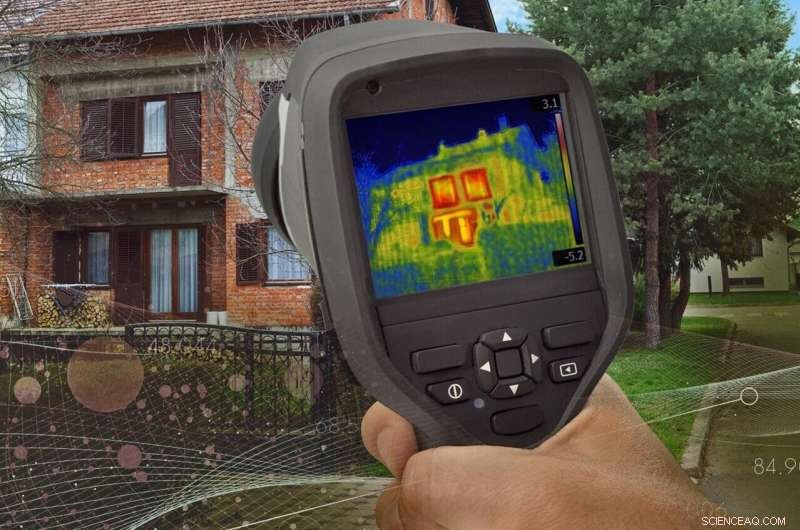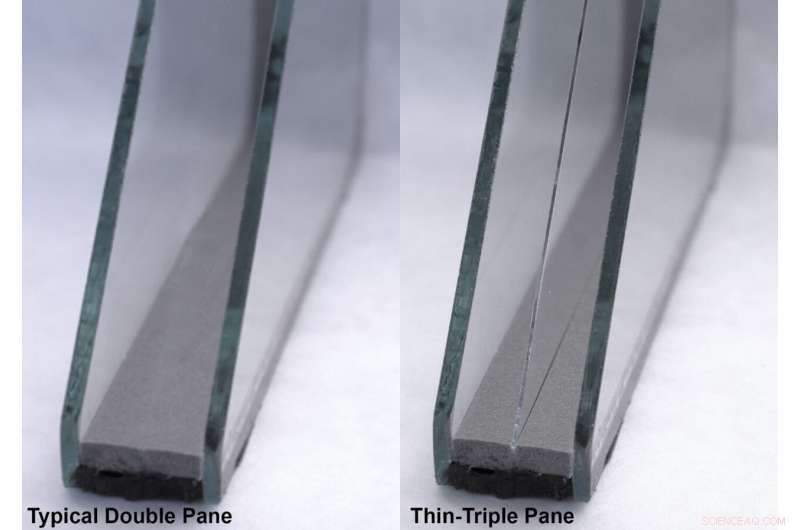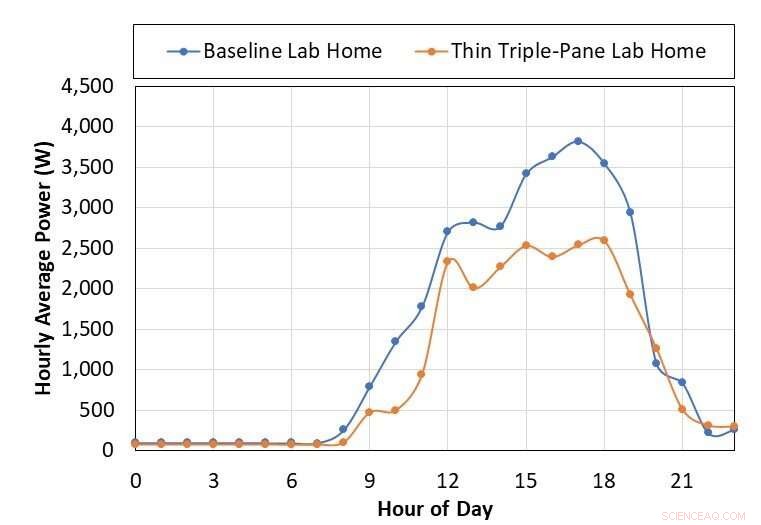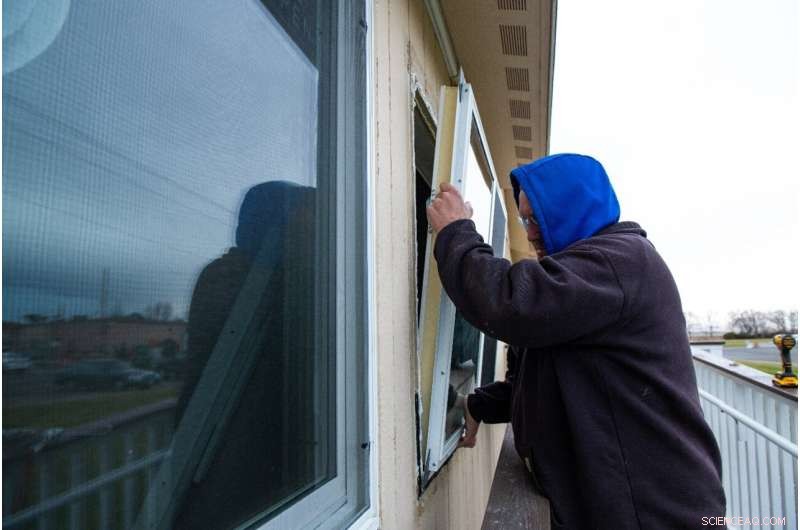
La tecnología de imágenes infrarrojas (IR) (que se muestra aquí) es una de las herramientas que se utilizan para medir la pérdida de calor a través de ventanas mal aisladas. Una serie de estudios de investigación muestra que una nueva generación de ventanas de triple panel puede ayudar a mejorar la eficiencia energética en los hogares. Crédito:Timothy Holanda | Laboratorio Nacional del Noroeste del Pacífico
Es hora de hacer el cambio a las ventanas de triple panel. Ese es el mensaje de una serie de estudios dirigidos por el Laboratorio Nacional del Noroeste del Pacífico del Departamento de Energía en colaboración con una coalición de socios públicos y privados.
"Costos más bajos, mayor disponibilidad y el impulso para reducir las emisiones de carbono nos están empujando hacia un punto de inflexión en el que las ventanas de triple panel comienzan a tener mucho sentido económico", dijo Kate Cort, economista investigadora de PNNL y gerente de programas de campo en curso. estudios de validación de ventanas de triple hoja.
No es ningún secreto que las ventanas de una casa pueden desperdiciar mucha energía. Pueden tener fugas de aire, e incluso los últimos modelos de ventanas de doble panel contribuyen significativamente al uso y costo de energía en un hogar. En una casa nueva, las ventanas suelen representar alrededor del 8 % de la superficie exterior, pero son responsables de la mitad de la pérdida o ganancia de calor. Esta pérdida de energía pasiva hace que las ventanas contribuyan de manera importante a los costos de calefacción y refrigeración del hogar.
Mientras tanto, la evidencia del ahorro de energía y costos de las ventanas de triple panel se ha ido acumulando lentamente durante años, desde que se introdujeron los primeros prototipos alrededor de 1989. Estudios anteriores han demostrado que las ventanas de triple panel son más eficientes energéticamente que las ventanas de doble panel estándar de la industria. variedad de paneles, pero la adopción del mercado ha sido lenta debido al costo y la disponibilidad.
Esas desventajas están a punto de cambiar, dijo Cort. Una nueva generación de ventanas delgadas de triple panel son menos costosas y se pueden adaptar más fácilmente a los marcos de doble panel existentes. Como su nombre lo indica, las ventanas de triple panel tienen tres paneles de vidrio que crean un sándwich de dos pisos, que se llena con un gas inerte, como el criptón, que brinda poder aislante adicional. Estas ventanas de próxima generación aprovechan las economías de escala proporcionadas por la misma tecnología avanzada de fabricación de vidrio que produce pantallas delgadas pero duraderas para televisores y computadoras.
En los últimos tres años, Cort y sus colegas han evaluado sistemáticamente el ahorro de energía y los factores económicos que determinarán qué tan rápido serán aceptados por los constructores. Este trabajo fue apoyado por la Oficina de Tecnologías de Construcción del DOE y la Administración de Energía de Bonneville.
Ahora los reguladores estatales de servicios públicos están comenzando a darse cuenta. Recientemente, el estado de Michigan usó datos de un estudio de campo de PNNL de ventanas de panel triple para incluirlas en la lista del manual de recursos técnicos del estado de medidas de ahorro de energía aprobadas elegibles para incentivos y reembolsos de servicios públicos.
Los nuevos estándares energéticos crean urgencia
Otro estudio reciente dirigido por Cort, el colega de PNNL Edward Louie y Robert Hart del Laboratorio Nacional Lawrence Berkeley mostró que para la construcción de viviendas nuevas, las ventanas de triple panel pueden ayudar a los constructores a cumplir de manera asequible con los códigos de energía más estrictos de 2021 para viviendas nuevas. Su estudio, publicado en la edición de marzo de 2022 de ASHRAE Journal mostró que cuando un constructor de viviendas actualiza las ventanas de una casa nueva de doble a triple panel, el rendimiento de eficiencia energética de las ventanas puede mejorar en un 40% o más. Este rendimiento adicional aumenta el valor de aislamiento total de todo el exterior de la casa, a menudo denominado envolvente del edificio.
"Nuestro estudio demostró que aumentar la eficiencia energética de las ventanas brinda a los constructores más flexibilidad en el diseño y la capacidad de hacer concesiones con otros componentes de la envolvente, como el aislamiento de paredes exteriores, mientras se cumple con el código", dijo Cort. The overall effect is to provide builders with more options and better assurance of building code compliance, while improving comfort for homeowners.

Thin triple-pane windows (right) have three panes of glass filled with an inert gas, krypton, and coated with a low-emission film to enhance energy efficiency. Credit:Lawrence Berkeley National Laboratory
What's the hold up for triple-pane windows?
Builders play a key role in the adoption of new home building technologies, said Cort. In 2020, she and her colleagues interviewed 29 home builders who have participated in the DOE Zero Energy Ready Home program. They asked builders to explain their decision-making process for window selection during the 2018 to 2019 building season. Forty-one percent of these builders used triple‐pane windows in all their new homes and another 28% in most or some of their homes. For those who didn't use triple-pane windows, the biggest factor was cost.
"The price differential between double-pane and triple-pane windows has been a pain-point for builders," Cort noted. But she added that the increased incremental material cost of triple-pane windows is now about $700 to $2,400 for a 2,400-square-foot wood-framed home. This is about the same cost as adding an extra inch of rigid wall insulation to the same home.
Some builders also stated that the indirect cost of custom installation for triple-pane windows, which can be 25% to 50% heavier than similar sized double‐pane windows, also weighed into their choice.
"Most builders aren't familiar with the newer thinner, lighter triple-pane technology," said Cort. But the survey showed most would be willing to try them if the cost and availability made it practical for them.

Thin triple-pane windows greatly reduced the power usage by the air-conditioning system in the hottest part of the day, compared with standard double-pane windows. The direct comparison was made in identical custom Lab Homes on the PNNL campus in summer 2020. Credit:Katherine Cort | Laboratorio Nacional del Noroeste del Pacífico
Some of the builders Cort's team interviewed noted that consumers like the comfort and quiet of triple-pane windows. A recent study confirmed that the installation of thin triple-panes reduced the sound infiltration by an average of 8-10 decibels when compared to the home with double-pane metal-frame windows, which roughly equates to reducing the perceived noise level by half.
"When someone comes into the house and you shut the door, it's like getting into a Mercedes or BMW," said a Seattle builder. "It's so solid and quiet. We are building homes next to Boeing Field airport in Seattle. Planes are flying right overhead so close you can clearly see them from the houses, and it is so quiet inside you can't hear them."
Demonstration projects lead the way
When there are new approaches to home building, said Cort, builders need assurances that materials will be available when needed, hold up under use, and deliver on promised improvements.
To help meet those expectations, PNNL has joined forces with DOE, Lawrence Berkley National Laboratory, and the Northwest Energy Efficiency Alliance to launch the Partnership for Advanced Window Solutions. With support from DOE, this public-private partnership is working with builders, utilities, and manufacturers to both drive demand and scale up production of cost-effective "drop-in" thin triple-pane window designs and other high-performance window solutions.

Installers insert thin triple-pane windows at a PNNL Lab Home, custom model homes on the PNNL campus built to conduct energy efficiency research. Credit:Andrea Starr | Laboratorio Nacional del Noroeste del Pacífico
The PNNL team recently compared the energy efficiency performance of these windows in its Lab Homes, a pair of identical manufactured homes used to study energy efficiency. During the winter heating season of 2019 and the summer cooling season of 2020, researchers recorded energy usage and temperatures throughout the homes. During the two 10-week evaluation periods, the windows saved an average of 12% on heating and 28% on cooling for the 1,500-square-foot structures. In addition, the home with the triple-pane windows reduced outdoor noise and maintained much more comfortable and even temperatures throughout the home during both summer and winter testing periods.
The research team is now field testing the windows in 10 locations nationwide, from manufactured homes in Pasco, Wash., to a net-zero apartment complex in Rotterdam, N.Y. In these field demonstration projects, the incremental cost over standard ENERGY STAR windows was $6 per square foot or less, said Cort. Within the last year, multiple versions of the thin-glass triple-pane units have been developed, certified by the National Fenestration Rating Council, and have become available to builders.
"At this point, it's a matter of increasing awareness among manufacturers, builders, utility programs, and consumers," said Cort. "It's time to look at windows, not just through them." + Explore further